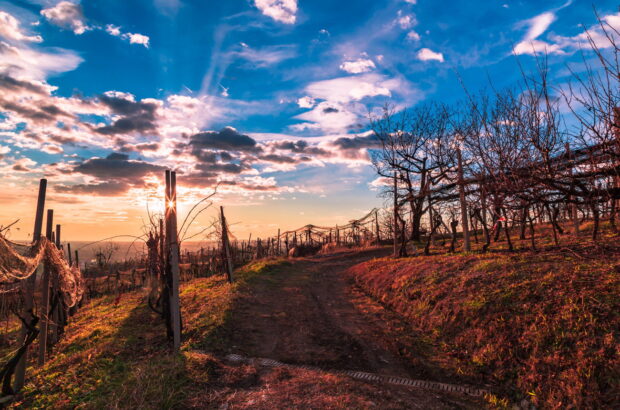While France is said to lead the world in cheesemaking, for sheer variety Italy is in a league of its own. From the Alps in the north to the central plains and the southern coasts, cheese production is ubiquitous. It’s estimated that 2,50 cheeses are made across the peninsula, with a new variety to be found roughly every 25km.
Italian cheeses are predominantly made from sheep’s and goat’s milk, as 75% of Italy’s landscape consists of hills and mountains, leaving few plains suitable for rearing cows. As many as 55 Italian cheeses have been granted PDO (Protected Designation of Origin) or PGI (Protected Geographical Indication) status within the European Union, with scores of others granted special protection within Italy in the form of PAT (Prodotto Agroalimentare Tradizionale) status.
With such a wealth of choice available, we sought insights from five of Italy’s top sommeliers, asking them to share their favourite wine pairings to go with five classic Italian cheeses.
Pecorino Toscano DOP

Region of origin: Tuscany (and some neighbouring municipalities in Lazio and Umbria)
The cheese: Pecorino Toscano is a semi-hard cheese made from sheep’s milk. Fresh Pecorino is aged for 20 days and has a delicate, sweet taste reminiscent of hay and butter. Aged Pecorino must be aged for at least 120 days, developing a more structured flavour profile of hazelnut, dried fruit and herbal notes.
The local wine match: An aged Vernaccia di San Gimignano, with its almond finish, pairs exceptionally well with the nutty flavours of aged Pecorino Toscano. A delightful way to end a meal is with a piece of aged Pecorino and a glass of vin santo (the Tuscan dessert wine made from dried grapes), a pairing in which the saltiness of the cheese is complemented by the nutty, sweet, yet fresh oxidative flavours of the vin santo.
The sommelier’s take: Clizia Zuin, from Michelin one-star restaurant Atto di Vito Mollica in Florence, suggests pairing aged Pecorino with Broadbent, 10 Year Old Verdelho Madeira (£40 Caviste): ‘The slight tingle of a Pecorino, imparted by a long ageing process, should be balanced with smoothness and freshness found in the wine, complemented by bold and austere flavours without frills. Madeira is versatile and pairs well with various cuisines. Verdelho, characterised by its freshness and moderate ageing, makes a perfect match.’
Parmigiano Reggiano DOP

Credit: Barbajones / Shutterstock
Region of origin: Emilia-Romagna, specifically between the cities of Parma and Reggio (hence the name), and in Modena, Bologna (left side of the Reno river) and Mantua (right of the Po river).
The cheese: Parmigiano Reggiano is a hard, granular cheese that is aged for a minimum of 12 months. It has a crumbly texture that becomes more pronounced with age, offering a rich, savoury and nutty flavour with a complex combination of fruity and salty notes. The flavour intensifies as the cheese ages.
The local wine match: A young piece of Parmigiano Reggiano with a glass of Lambrusco is a local favourite. The savoury and nutty flavours of the cheese pair well with the fresh and fruity tones of this joyful red semi-sparkling wine; the delicate Lambrusco Sorbara for younger cheeses and the more aromatic and structured Lambrusco Grasparossa for aged versions.
The sommelier’s take: Giuseppe Palmieri from the Michelin three-star restaurant Osteria Francescana in Modena suggests: ‘A very well-aged Parmigiano Reggiano pairs excellently with a blonde double malt beer from the Bolognese Apennines, with its smoky notes of chestnuts and juniper character. The milk used for Parmigiano Reggiano is also commonly used to make a semi-soft cheese called caciotte. I love the pairing of caciotte with toasted three- to four-day-old bread, a glass of vermouth from Romagna with ice, two slices of lemon and a touch of local sparkling water.’
Gorgonzola DOP

Credit: Istetiana via Getty Images
Region of origin: Lombardy
The cheese: Gorgonzola is known for its distinctive flavour, creamy texture and characteristic marbled blue or green veins, created by adding Penicillium glaucum mould to cow’s milk. It’s aged from a few months to more than a year. The flavour is rich, tangy and slightly spicy, varying from mild and creamy in younger versions to intense and piquant in aged versions.
The local wine match: The acidity, moderate tannins and fruity aromatics of a Rosso di Valtellina made with Nebbiolo (Chiavennasca in Lombardy) complement the creamy, rich complexity of Gorgonzola.
The sommelier’s take: Gianluca Sanso from Michelin one-star Cracco in Milan says: ‘I pair Gorgonzola with a Moscato di Scanzo [a dessert wine made from dried red grapes] from Azienda Agricola Biava, which offers a perfect mix of softness and firmness to pair with the complex three-dimensionality of Gorgonzola. Alternatively, the Meteri, Giardino delle Bolle Rosato metodo classico sparkling from Oltrepò Pavese – all Pinot Noir, aged for eight years on the lees – provides excellent complexity and freshness to counterpoint the rich and opulent structure of Gorgonzola.’
Burrata di Andria IGP

Credit: Istock / Getty Images Plus
Region of origin: Puglia
The cheese: Made with cow’s milk, Burrata is known for its unique structure: the outer shell is solid Mozzarella, the inside contains stracciatella and cream, giving it a soft, creamy and luscious texture contrasting with the firmer exterior.
The local wine match: A fresh rosé wine made from the Negroamaro grape variety, with its fruitiness and freshness, balances the rich flavour of Burrata.
The sommelier’s take: Rubén Pérez Jiménez from Michelin one-star restaurant Bros’ in Lecce, Puglia, suggests: ‘For a soft, sweet and slightly acidic cheese like Burrata, the ideal pairing is a sparkling wine to contrast its richness, or a white with medium structure and persistent acidity. A favourite of mine is the local sparkling wine Marasco IGP Salento from the natural wine producer L’Archetipo. Made from the Maresco grape, this wine is straightforward and slightly aromatic. It is fresh, juicy and savoury, moving nimbly in the mouth without sacrificing smoothness and roundness. A delicate wine that stands out for its liveliness and matches perfectly with Burrata.’
Mozzarella di Bufala Campania DOP

Credit: Barmalini / Shutterstock
Region of origin: Campania (also produced in Puglia, Lazio and Molise)
The cheese: Mozzarella di Bufala is a soft cheese made from water buffalo milk, which has a higher fat content than cow’s milk, contributing to the cheese’s rich flavour and creamy texture. The flavour is mild, slightly tangy and creamy with a hint of sweetness. It is best enjoyed fresh within a couple of days of production.
The local wine match: The creamy, slightly sweet flavour of buffalo Mozzarella pairs perfectly with the region’s traditional sparkling wine, Asprinio di Aversa, a high-acid, lemony wine that cleanses the palate with each sip. Asprinio is a grape variety found in the Aversa area, where its ungrafted vines grow attached (‘married’) to poplar and mulberry trees, reaching heights of 10m-15m. This refreshing sparkling wine is made using the Charmat method.
The sommelier’s take: Roberto Adduono from Michelin two star Tre Olivi del Savoy Hotel & Spa di Paestum recommends: ‘My go-to is San Salvatore 1988’s Vetere IGP Paestum rosé. This elegant rosato – made from pure Aglianico and cold-macerated for six hours – has a Provençal-style colour but embodies the essence of Cilento [a coastal region of Campania]. The freshness and youthful character of Vetere intersect beautifully with the rich and succulent texture of Mozzarella di Bufala Campania DOP, creating an inescapable territorial pairing.’







